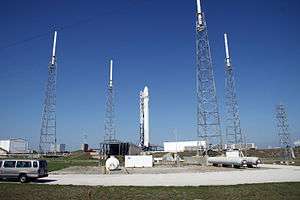Cape Canaveral Air Force Station Space Launch Complex 40
 SLC-40 in May 2012 with Falcon 9 rocket carrying Dragon C2+ | |||||||||||
| Launch site | Cape Canaveral Air Force Station | ||||||||||
|---|---|---|---|---|---|---|---|---|---|---|---|
| Location | 28°33′44″N 80°34′38″W / 28.562106°N 80.577180°WCoordinates: 28°33′44″N 80°34′38″W / 28.562106°N 80.577180°W | ||||||||||
| Short name | SLC-40 | ||||||||||
| Operator | United States Air Force | ||||||||||
| Total launches | 68 | ||||||||||
| Launch pad(s) | 1 | ||||||||||
| Min / max orbital inclination | 28°–57° | ||||||||||
| |||||||||||
Cape Canaveral Air Force Station Space Launch Complex 40[1][2] (SLC-40), previously Launch Complex 40 (LC-40) is a launch pad at the north end of Cape Canaveral, Florida.
The launch pad was used by the United States Air Force for 55 Titan III and Titan IV launches between 1965 and 2005.[3]
After 2007, the US Air Force leased the complex to Space Exploration Technologies (SpaceX) to launch the Falcon 9 rocket.[4] The pad has been used for 13 Falcon 9 launches from 2010 through early 2015.[5]

Titan

The first launch from LC-40 was the maiden flight of the Titan IIIC (June 18, 1965), carrying two transtage upper stages to test the functionality of the vehicle.
Two interplanetary missions were launched from the pad:
- The failed Mars Observer spacecraft (September 25, 1992)
- The Cassini–Huygens mission to Saturn (October 15, 1997)
A total of 30 Titan IIICs, 8 Titan 34Ds and 17 Titan IVs were launched between 1965 and 2005.[3]
The final Titan launch from SLC-40 was the Lacrosse-5 reconnaissance satellite (Titan IV-B, April 30, 2005).
The tower was disassembled during late 2007 and early 2008. Demolition of the Mobile Service Structure (MSS), by means of a controlled explosion, occurred on April 27, 2008, by Controlled Demolition, Inc.[6]
.jpg)
Falcon
On April 25, 2007, the US Air Force leased the complex to SpaceX to launch the Falcon 9 rocket.[4]
During April 2008, construction started on the ground facilities necessary to support the launch of the SpaceX Falcon 9 rocket. Renovations included installation of new liquid oxygen and kerosene tanks and construction of a hangar for rocket and payload preparation.
The first Falcon 9 rocket arrived at SLC-40 in late 2008, and was erected for the first time on January 10, 2009.[7] It successfully reached orbit on its maiden launch on June 4, 2010, carrying a dummy payload qualification unit.
SLC-40 is the launch facility of the SpaceX Dragon, a reusable automated cargo vehicle which is currently being used to provide two-way logistics to and from the International Space Station; a role previously filled by the Space Shuttle until its retirement in 2011.[8] SpaceX successfully launched the first test flight for the Dragon from SLC-40 on December 8, 2010. Its first attempt to dock with the International Space Station was successfully launched on May 22, 2012, following an abort after engine ignition three days earlier.
SpaceX modified the launch pad in 2013 in order to support launches of the Falcon 9 v1.1 launch vehicle, a 60 percent heavier rocket with 60 percent more thrust on realigned engines[9] and 60 percent longer fuel tank than the v1.0 version of the Falcon 9, requiring a modified transporter/erector.[10]
In March 2014, SpaceX announced that they intend to upgrade and modify the LC40 pad in order to accommodate Falcon Heavy launches in addition to the existing Falcon 9 launch capability.[11]
References
| Wikimedia Commons has media related to Cape Canaveral Air Force Station Space Launch Complex 40. |
| Wikinews has related news: Last Titan launch complex at Cape Canaveral demolished |
- ↑ McDowell, Jonathan (1998-02-22). "Issue 350". Jonathan's Space Report. Jonathan's Space Page. Retrieved 2009-07-09.
- ↑ "Table 3". Retrieved 9 October 2014.
- 1 2 "Launch Complex 40". Afspacemuseum.org. Retrieved 2014-08-16.
- 1 2 Kelly, John (April 25, 2007). "SpaceX cleared for Cape launches". Florida Today. Archived from the original on September 30, 2007. Retrieved June 5, 2010.
- ↑ "Launch Manifest". SpaceX.
- ↑ Hidalgo Whitesides, Loretta (May 1, 2008). "Launch Pad Demolition Clears Way for SpaceX Rockets". Wired. Retrieved June 5, 2010.
- ↑ Shanklin, Emily (January 12, 2009). "SpaceX's Falcon 9 on Launch Pad at Cape Canaveral". SpaceX.com. Retrieved June 5, 2010.
- ↑ "NASA Selects SpaceX's Falcon 9 Booster and Dragon Spacecraft for Cargo Resupply Services to the International Space Station". SpaceX.com. December 23, 2008. Retrieved January 26, 2009.
- ↑ "Falcon 9's commercial promise to be tested in 2013". Spaceflight Now. Retrieved 17 November 2012.
- ↑ Klotz, Irene (2013-09-06). "Musk Says SpaceX Being "Extremely Paranoid" as It Readies for Falcon 9’s California Debut". Space News. Retrieved 2013-09-13.
- ↑ Gwynne Shotwell (2014-03-21). Broadcast 2212: Special Edition, interview with Gwynne Shotwell (audio file). The Space Show. Event occurs at 20:00–21:10. 2212. Archived from the original (mp3) on 2014-03-22. Retrieved 2014-03-22.
| ||||||||||||||
| ||||||||||||||||||||||||||||||||||||||||||||||||||||||||||||||||||||||||